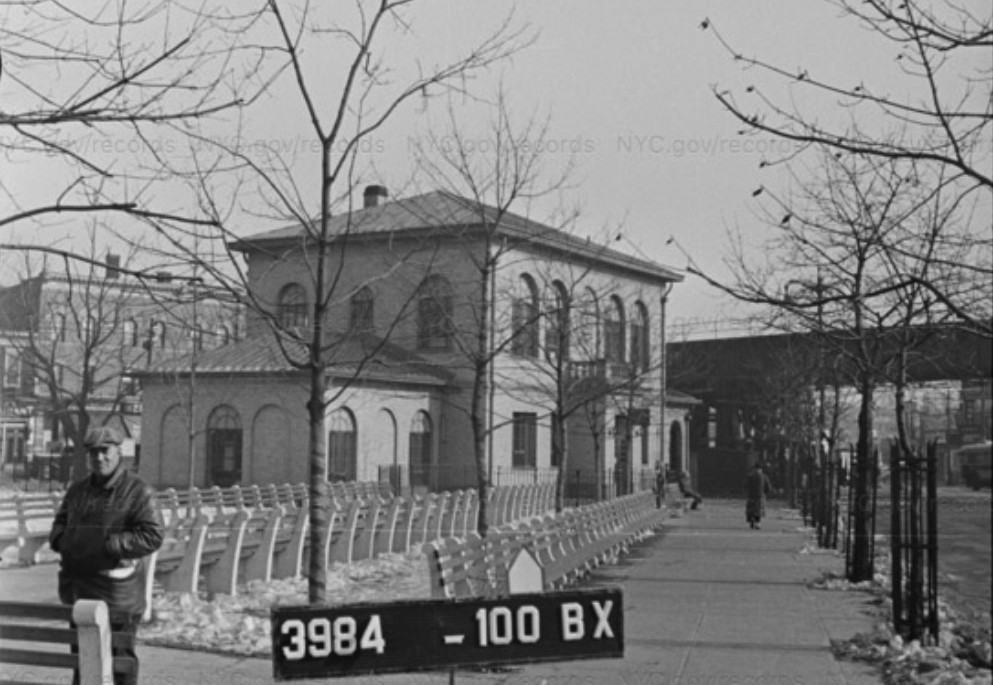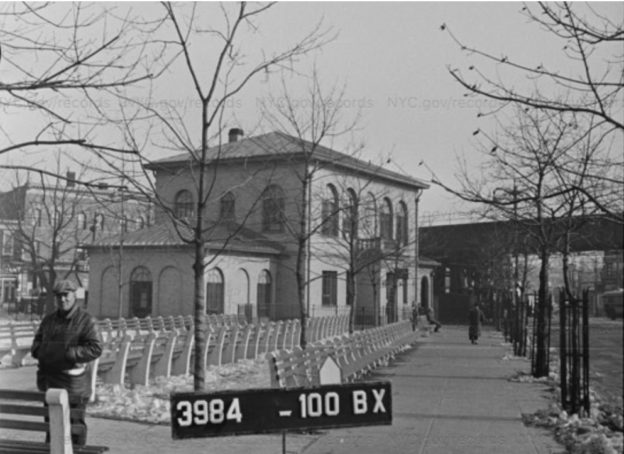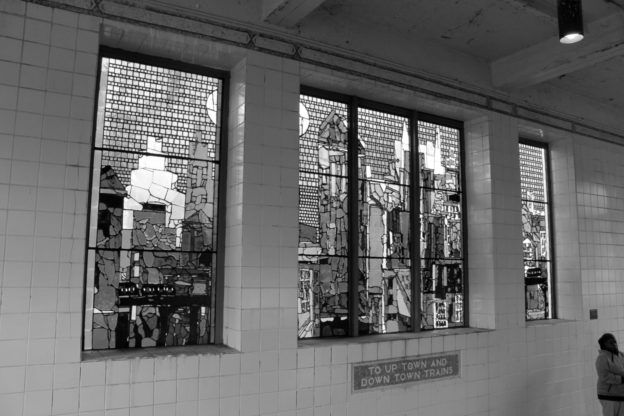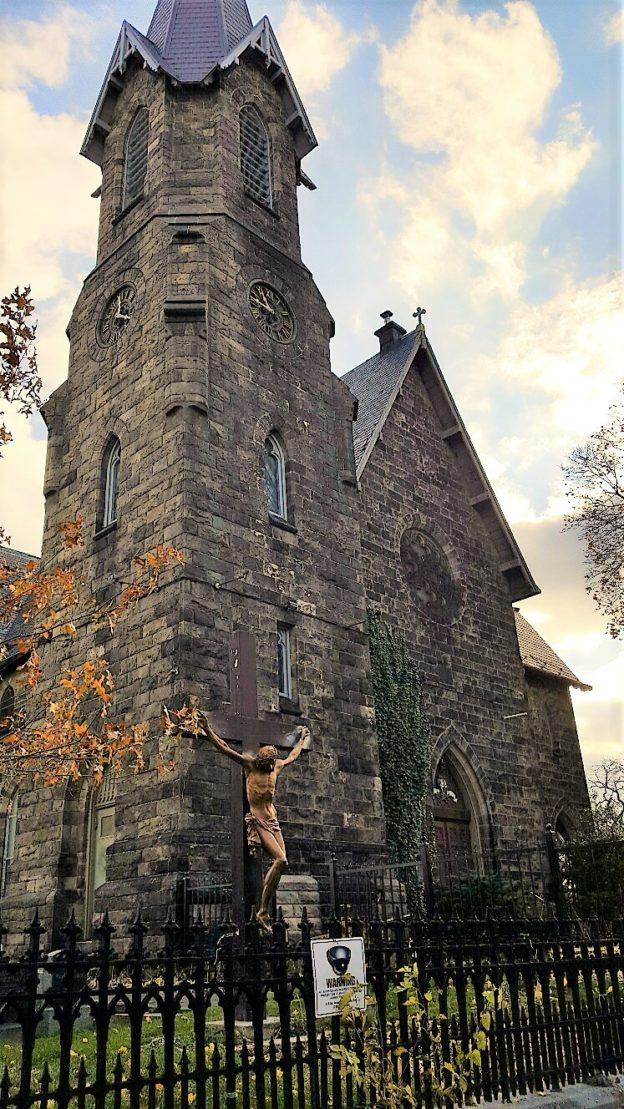2551 Westchester Avenue
Park: 1907; Recreation Center: 1927; Alterations: 1983, John Ciardullo
Acquired by the city through two purchases in 1907 and 1909, this park was known as Westchester Square until 1925, when it was renamed after Owen Dolen, a local educator who died after speaking at the dedication ceremony for the park’s World War I monument. Benson Street divided the two parcels of this park until 1993, at which point a portion of the street was closed and replaced with vegetation that expanded the footprint of the park. The recreation center, built in 1927, was initially designed to serve as the park’s comfort station before being converted to a branch of the New York Public Library in the 1930s. Designed with elements of the Spanish Revival style, the recreation center consists of a two-story, five-bay central building and two three-bay, one-story wings, all of which are characterized by large round arch windows and entryways. In 1982, the New York City Department of Parks & Recreation hired John Ciardullo Associates to redesign the building for use as the Owen Dolen Golden Age Center, which included a new entryway with a triangular facade built of architectural concrete, as well as ample space for programming serving senior citizens.
Photo courtesy of NYC Municipal Archive.
2551 Westchester Avenue
Owen F. Dolen Park
1987, David Saunders
David Saunders designed this bronze sculpture, sited on a base of engraved Stony Creek granite. Dedicated in 1987, it references 19th century monuments that often featured a seated figure. Seat encourages viewers to consider themselves in the chair and is thus a monument to everyone. Beneath the chair rests a dictionary open to a plate depicting the “Common Birds of America”, while the granite boulder itself is engraved with imagery of a wild boar with her four piglets on the sides. Commissioned by the Public Art Fund, Seat was the winner of the New York City Art Commission’s 1985 Excellence in Design Award. David Saunders, a native New Yorker, has completed public sculptures displayed both elsewhere in The Bronx and abroad and has work featured at the Museum of Modern Art and Metropolitan Museum of Art, among others.
East Tremont Ave. & Westchester Ave.
1920
Squire J. Vickers
Completed in 1920 as part of the Dual Contracts subway system expansion, the Westchester Square — East Tremont Avenue station sits on the Interborough Rapid Transit Company’s Pelham Line, which stretches from the South Bronx to Pelham Bay Park. Westchester Square had retained the feel of a rural village center until the arrival of the subway, upon which the area rapidly developed into a residential commuter community with a variety of housing stock. A 1916 Public Service Commission report on the plans for the Pelham Line outlines the construction of three ornamental concrete stations, including one at Westchester Square, as well as a fixed bridge spanning The Bronx River and New Haven Railroad right of way. This elevated station consists of a steel frame structure and concrete facade, with a stair tower on the western side decorated with inlays of blue, green and orange ceramic tiles arranged in geometric patterns. Squire Vickers, who designed a majority of stations constructed as part of the Dual Contracts and Independent Subway Systems, was known for his utilitarian spaces complemented by colorful tilework. The interiors of the station mezzanine and stair tower were renovated in 1993 to include new terrazzo floors, ceramic wall tiles, glass block openings and a new stained glass window titled City of Light and designed by Romare Bearden. The Westchester Square — East Tremont Avenue station is listed on the State and National Register of Historic Places.
East Tremont Ave. & Westchester Ave.
1993
Romare Bearden
This three-paneled glass installation, also known as a triptych, greets commuters as they ascend the first flight of stairs at the elevated Westchester Square/East Tremont Avenue station. The colored glass vividly portrays a city skyline with a black subway train threading through the buildings. The artist, Romare Bearden, was a social worker in New York CIty for three decades who produced art in his free time, experimenting with a variety of mediums but primarily known for his collages. His only work in glass, City of Light was initially executed as a collage maquette before Bearden submitted his proposal to the MTA in 1983. Although Bearden died in 1988, glass fabricators Benoit Gilsoul and Helmut Schardt faithfully followed the artist’s sketches to produce the work that now graces the subway station stairway. This work was funded through the Metropolitan Transportation Authority’s Percent for Art program, which has competitively selected over 300 artists to produce permanent works throughout the agency’s properties since the 1980s.
2500 Westchester Avenue
Church: 1855, Chapel: 1868, Leopold Eidlitz; Cemetery: ca. 1750s
Founded in 1693, the parish of Saint Peter’s saw its first church completed in 1700 with funds collected through a tax on residents in the towns of Westchester, Eastchester, and Yonkers, along with the manor of Pelham. The Gothic church standing today was completed in 1855, and was designed by Leopold Eidlitz, who had recently completed St. George’s Church in Stuyvesant Square, Manhattan. Rough-cut beige stone is utilized throughout the facade, including the archways and frames. Key features include a four-sided spire with clock faces and the entrance steps’ marble walls with Gothic carvings. The church’s cemetery, which contains graves dating to the 1750’s, includes both modest headstones and elaborate tombs and serves as the final resting place of soldiers killed during the Revolutionary War. The Chapel was also designed by Eidlitz following the same Gothic style, and was completed in 1868. It has served as the home of The Bronx Academy of Arts and Dance (BAAD!) since 2013. For more information on BAAD!, see HDC’s 2018 Cultural Landmarks guidebook St. Peter’s Church is a NYC Individual Landmark.





